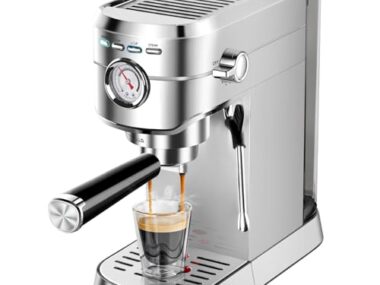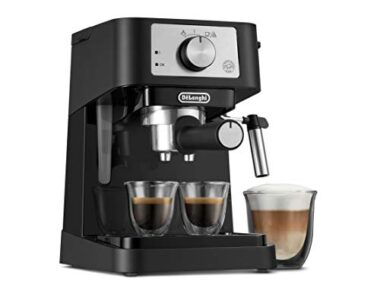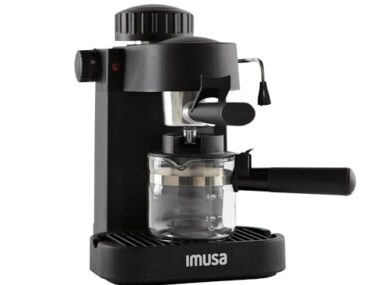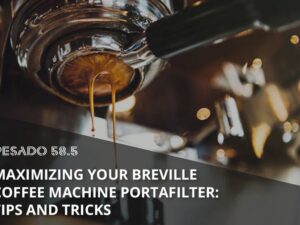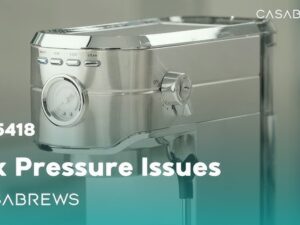If you want to enjoy a perfect espresso right at home, knowing how to use your espresso machine properly is the key. Maybe you’ve bought a fancy machine, but the coffee just doesn’t taste as good as you hoped.
Don’t worry—making great espresso isn’t as complicated as it seems. By mastering a few simple steps, you’ll unlock rich flavors and creamy textures that make every cup special. In this guide, you’ll learn exactly what to do, from prepping your machine to pulling that flawless shot.
Get ready to impress yourself and anyone you share your espresso with!
Espresso Machine Parts
Understanding the main parts of an espresso machine helps in using it properly. Each part has a special job to make espresso taste great. Knowing these parts makes the process easier and more enjoyable.
Grouphead And Portafilter
The grouphead is where hot water meets coffee grounds. It holds the portafilter in place. The portafilter holds the coffee grounds tightly packed. Water flows through the portafilter to extract espresso. Keeping these parts clean is important for good flavor.
Steam Wand And Boiler
The steam wand creates steam to heat and froth milk. It is usually a metal pipe on the side of the machine. The boiler heats water to the right temperature for brewing and steaming. Proper temperature control ensures the espresso is not bitter or weak.
Pressure Gauge And Controls
The pressure gauge shows the water pressure during extraction. Correct pressure helps pull the perfect shot of espresso. Controls let you adjust temperature, pressure, and steam. Learning to use these controls gives you better coffee results.

Credit: www.reddit.com
Choosing Coffee Beans
Choosing the right coffee beans plays a big role in making great espresso. The beans affect the flavor, aroma, and quality of your shot. Understanding the key factors of coffee beans helps you get the best taste from your espresso machine.
Bean Freshness
Fresh beans make a stronger, richer espresso. Coffee starts to lose flavor soon after roasting. Buy beans from a recent roast date. Store them in an airtight container away from light. Avoid pre-ground coffee for espresso. Grinding just before brewing keeps freshness.
Roast Levels
Different roast levels suit different espresso tastes. Dark roasts create bold, intense flavors with less acidity. Medium roasts balance acidity and body for a smooth cup. Light roasts highlight fruity and floral notes but have higher acidity. Choose the roast that matches your taste preference.
Grind Size Importance
Grind size affects extraction and espresso quality. Espresso needs a fine grind for proper pressure and flavor release. Too coarse grind causes weak, watery shots. Too fine grind leads to bitter, over-extracted espresso. Adjust grind size to get a balanced shot with your machine.
Preparing The Machine
Preparing your espresso machine correctly sets the stage for a rich, flavorful cup. This step ensures the machine works smoothly and produces consistent coffee. Taking time to get the machine ready can improve every shot you pull.
Preheating The Machine
Turn on your espresso machine and let it warm up. Most machines need about 15 to 30 minutes to reach the ideal temperature. Preheating helps keep the water hot enough for proper extraction. Avoid rushing this step, as cold machines produce weak espresso.
Cleaning Components
Clean the portafilter, basket, and group head before use. Residue from old coffee oils can ruin the taste. Use a damp cloth or brush to remove grounds. Regular cleaning prevents clogging and keeps the machine working well. Clean parts also ensure a fresh flavor every time.
Water Quality Tips
Use fresh, filtered water for the best espresso taste. Poor water quality affects flavor and can damage the machine. Avoid hard water that causes scale build-up. Change water daily and use soft water if possible. Good water makes your espresso smooth and balanced.
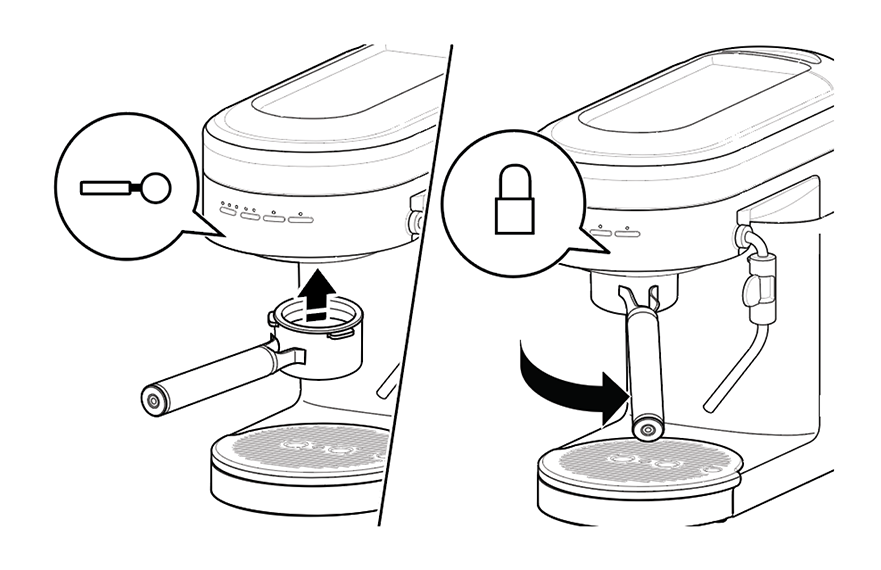
Credit: www.kitchenaid.com
Dosing And Tamping
Dosing and tamping are key steps in brewing a rich espresso shot. Proper dosing ensures the right amount of coffee grounds. Tamping compresses these grounds evenly for balanced extraction. Skipping or rushing these steps leads to weak or bitter coffee. Focus on accuracy and consistency in both steps to enjoy a smooth, flavorful espresso every time.
Measuring Coffee Dose
Start by weighing your coffee dose. Use a digital scale for accuracy. Most espresso recipes call for 18 to 20 grams of coffee. Too little coffee makes weak espresso. Too much can cause clogging and bitterness. Measure each dose precisely for consistent results.
Even Distribution Techniques
After dosing, spread the coffee evenly in the portafilter. Use your finger or a distribution tool to level the grounds. Avoid clumps or uneven piles. Even distribution prevents channeling, where water flows too fast through weak spots. This step ensures all coffee grounds extract evenly.
Applying Consistent Pressure
Tamping compresses the coffee into a compact puck. Hold the tamper firmly and press down with about 30 pounds of pressure. Keep the tamper level to avoid uneven extraction. Use a smooth, steady motion. Consistent tamping pressure helps water flow evenly through the coffee bed.
Pulling The Perfect Shot
Pulling the perfect shot is the heart of espresso making. It defines the taste, aroma, and body of your coffee. This process needs precision and attention to detail. Each step affects the final cup.
Focus on how you lock the portafilter, control the shot timing, and monitor the extraction. These steps ensure a balanced and rich espresso shot every time.
Locking The Portafilter
Start by filling the portafilter with freshly ground coffee. Tamp it evenly with firm pressure. Place the portafilter into the group head. Turn it firmly to lock it in place. A secure lock prevents water leaks and ensures even pressure.
Check that it feels tight but not forced. A loose portafilter causes weak shots. Too tight can damage the machine.
Shot Timing
Start the shot immediately after locking the portafilter. Aim for an extraction time between 25 to 30 seconds. This range extracts the right flavors without bitterness. Use a timer or the espresso machine’s built-in shot timer.
Too short means under-extraction, weak and sour coffee. Too long means over-extraction, bitter and harsh taste. Adjust the grind size or dose if your timing is off.
Monitoring Extraction
Watch the espresso as it flows into the cup. It should start with a dark, thick stream. Then turn golden and creamy, like honey. The flow must be steady and slow, not fast or dripping.
Stop the shot at the right time to avoid over or under-extraction. A good shot has a rich crema on top. This shows the coffee oils and freshness. Practice watching the extraction to improve your espresso skills.
Steaming And Texturing Milk
Steaming and texturing milk is essential for making delicious espresso drinks. It adds creaminess and sweetness to your coffee. Proper technique creates smooth, velvety milk that blends well with espresso. Follow these steps to get the best milk texture for lattes, cappuccinos, and more.
Creating The Milk Vortex
Start by filling your pitcher with cold milk. Place the steam wand just below the surface. Turn on the steam to create a whirlpool or vortex in the milk. This motion mixes air evenly, helping to create smooth texture. Keep the pitcher steady to maintain the vortex. Avoid large bubbles by controlling the steam pressure.
Achieving Microfoam
Microfoam is milk with tiny, fine bubbles. It feels silky and thick. To achieve this, keep the steam wand near the surface at first. Let air in slowly for a few seconds. Then, lower the wand deeper to heat the milk. The vortex will help break big bubbles into smaller ones. Stop steaming when the milk looks shiny and creamy.
Milk Temperature Guidelines
Heat milk between 140°F and 150°F (60°C to 65°C). This temperature enhances sweetness without burning the milk. Use a thermometer or feel the pitcher’s side. It should be hot but comfortable to touch. Avoid overheating, which causes bitter taste and scalded milk. Let the milk rest for a few seconds before pouring.
Troubleshooting Common Issues
Troubleshooting common issues helps you enjoy better espresso. Small problems affect taste and machine life. Fixing them early saves time and money. Below are solutions for typical problems with espresso machines.
Bitter Or Sour Taste
Bitter coffee means over-extraction. Use coarser coffee grounds. Shorten brewing time. Sour taste means under-extraction. Use finer grounds. Increase brewing time slightly. Check water temperature. Ideal is 195-205°F (90-96°C). Avoid stale beans. Fresh beans make sweeter espresso.
Crema Problems
Thin or no crema means poor extraction. Use fresh, high-quality beans. Check grind size; it should be fine but not powdery. Tamp coffee evenly and firmly. Clean the group head regularly. Old coffee oils block crema. Ensure correct water pressure; 9 bars is standard. Proper temperature also affects crema quality.
Machine Maintenance
Clean the machine daily. Rinse the portafilter and group head after use. Descale regularly to remove mineral buildup. Use manufacturer-recommended descaling solutions. Empty and clean the drip tray. Check and replace water filters if needed. Regular maintenance keeps coffee taste pure and machine working well.
Advanced Tips For Consistency
Consistency is key to great espresso. Advanced techniques help keep each shot reliable. Small adjustments improve taste and texture every time. These tips focus on precise control over brewing variables.
Using the right tools and methods ensures you get the best flavor. Precision leads to a balanced and smooth espresso. Here are important steps to maintain consistency in your brewing process.
Dialing In Grind Size
Grind size affects how water flows through coffee grounds. Finer grinds slow down extraction, creating stronger flavors. Coarser grinds speed it up, making lighter coffee. Adjust the grind to match your machine and beans. Test small changes and observe the taste. The goal is to reach an even, balanced shot every time.
Adjusting Brew Ratios
Brew ratio means the amount of coffee to water used. Changing this ratio shifts the strength and flavor of espresso. More coffee or less water makes a bolder shot. Less coffee or more water softens the taste. Start with a standard ratio like 1:2 and tweak from there. Keep notes to find what works best for your beans.
Using Scales And Timers
Scales help measure coffee dose accurately. Timers track how long espresso extracts. Both tools reduce guesswork and errors. Weigh coffee before and after brewing for precision. Use a timer to stop extraction at the right moment. Consistent measurements ensure every cup tastes the same.
Cleaning And Maintenance
Proper cleaning and maintenance keep your espresso machine working well. Dirt and coffee oils build up fast. This affects taste and machine life. Clean parts regularly to enjoy fresh coffee every day. Follow simple steps to keep your machine in top shape.
Daily Cleaning Routine
Rinse the portafilter and basket after each use. Wipe the steam wand with a damp cloth. Purge steam to clear milk residue. Empty the drip tray daily. Clean the group head with a brush to remove coffee grounds. Use warm water to rinse all removable parts.
Descaling Procedures
Descale your machine to remove mineral deposits. Use a descaling solution or vinegar mixed with water. Run the solution through the machine as if brewing coffee. Repeat with clean water to rinse. Descale every one to three months depending on water hardness. This prevents blockages and keeps water flowing well.
Replacing Parts
Check the gasket and shower screen regularly. Replace them if they look worn or cracked. Change the water filter as recommended by the manufacturer. Replace the steam wand tip if it clogs often. Using original parts ensures the best fit and function. Regular part replacement keeps your espresso machine reliable.
Espresso Recipes To Try
Espresso lovers can explore many tasty recipes to enjoy their coffee. Using an espresso machine opens a world of flavors. Simple drinks to fancy creations all start with a perfect shot. Trying different recipes helps you learn the machine and enjoy coffee more.
Classic Espresso
The classic espresso is strong and pure. Use fresh, finely ground coffee beans for the best taste. Tamp the grounds evenly in the portafilter. Pull a shot that lasts about 25-30 seconds. This makes a rich, smooth espresso with a golden crema on top. Drink it straight or use it as a base for other drinks.
Cappuccino And Latte
Cappuccino and latte are popular espresso-based drinks. Both start with a shot of espresso. For a cappuccino, add equal parts steamed milk and milk foam. It has a light, airy texture on top. A latte uses more steamed milk and less foam. This makes it creamier and milder in taste. Both are easy to make once you master steaming milk.
Creative Variations
Try creative variations to keep coffee fun. Add flavored syrups like vanilla, caramel, or hazelnut. Mix espresso with cold milk and ice for an iced latte. Combine espresso with chocolate for a mocha treat. Experiment with spices like cinnamon or nutmeg on top. These variations bring new flavors while using your espresso machine.

Credit: www.wikihow.com
Frequently Asked Questions
How To Correctly Use An Espresso Machine?
Preheat the machine and portafilter. Grind fresh coffee finely. Tamp evenly with firm pressure. Lock portafilter tightly. Start shot extraction, aiming for 25-30 seconds. Steam milk by creating a vortex. Clean the machine after each use to maintain flavor and performance.
What Is The 10 Second Rule For Espresso?
The 10 second rule for espresso means starting the shot within 10 seconds after tamping. This prevents coffee grounds from drying out, ensuring optimal flavor extraction.
What Is The 2:1 Rule For Espresso?
The 2:1 rule for espresso means using twice the liquid output compared to the coffee dose. For example, 18g grounds yield 36g espresso. This ratio balances strength and flavor for a well-extracted shot.
What Is The Golden Rule Of Espresso?
The golden rule of espresso is to use the right grind size and tamp pressure for a balanced, flavorful shot every time.
Conclusion
Using an espresso machine takes practice and patience. Start with clean, warm equipment every time. Measure your coffee grounds carefully for the best taste. Pay attention to water temperature and extraction time. Keep the machine maintained to ensure smooth operation.
With regular use, your espresso will improve steadily. Enjoy the process and savor each fresh shot. A good espresso brightens your day and lifts your mood. Keep experimenting to find your perfect cup.

